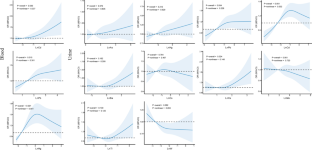Environmental Geochemistry and Health ( IF 4.2 ) Pub Date : 2024-04-05 , DOI: 10.1007/s10653-024-01929-0 Xiaodie Yao , Mei Jiang , Yunyun Dong , Juan Wen , Hua Jiang

|
There is limited evidence linking exposure to heavy metals, especially mixed metals, to stress urinary incontinence (SUI). This study aimed to explore the relationship between multiple metals exposure and SUI in women. The data were derived from the National Health and Nutrition Examination Survey (NHANES), 2007–2020. In the study, a total of 13 metals were analyzed in blood and urine. In addition, 5155 adult women were included, of whom 2123 (41.2%) suffered from SUI. The logistic regression model and restricted cubic spline (RCS) were conducted to assess the association of single metal exposure with SUI risk. The Bayesian kernel machine regression (BKMR) and weighted quantile sum (WQS) were used to estimate the combined effect of multiple metals exposure on SUI. First, we observed that blood Pb, Hg and urinary Pb, Cd were positively related to SUI risk, whereas urinary W was inversely related by multivariate logistic regression (all p-FDR < 0.05). Additionally, a significant non-linear relationship between blood Hg and SUI risk was observed by RCS analysis. In the co-exposure models, WQS model showed that exposure to metal mixtures in blood [OR (95%CI) = 1.18 (1.06, 1.31)] and urine [OR (95%CI) = 1.18 (1.03, 1.34)] was positively associated with SUI risk, which was consistent with the results of BKMR model. A potential interaction was identified between Hg and Cd in urine. Hg and Cd were the main contributors to the combined effects. In summary, our study indicates that exposure to heavy metal mixtures may increase SUI risk in women.
中文翻译:

女性接触多种金属与压力性尿失禁之间的关联:混合方法
将接触重金属(尤其是混合金属)与压力性尿失禁 (SUI) 联系起来的证据有限。本研究旨在探讨女性多种金属暴露与 SUI 之间的关系。数据来自 2007-2020 年国家健康和营养检查调查 (NHANES)。在这项研究中,总共分析了血液和尿液中的 13 种金属。此外,还纳入了 5155 名成年女性,其中 2123 名(41.2%)患有 SUI。采用逻辑回归模型和限制三次样条 (RCS) 来评估单一金属暴露与 SUI 风险的关联。使用贝叶斯核机器回归 (BKMR) 和加权分位数和 (WQS) 来估计多种金属暴露对 SUI 的综合影响。首先,我们观察到,通过多变量 Logistic 回归,血 Pb、Hg 和尿 Pb、Cd 与 SUI 风险呈正相关,而尿 W 呈负相关(所有p -FDR < 0.05)。此外,RCS 分析观察到血汞与 SUI 风险之间存在显着的非线性关系。在共同暴露模型中,WQS 模型显示,暴露于血液 [OR (95%CI) = 1.18 (1.06, 1.31)] 和尿液 [OR (95%CI) = 1.18 (1.03, 1.34)] 中的金属混合物与SUI风险呈正相关,这与BKMR模型的结果一致。尿液中的汞和镉之间存在潜在的相互作用。汞和镉是综合效应的主要贡献者。总之,我们的研究表明,接触重金属混合物可能会增加女性 SUI 的风险。



























 京公网安备 11010802027423号
京公网安备 11010802027423号